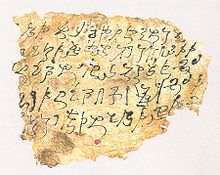
Back Kharosthi Afrikaans खरोष्ठी लिपि ANP খরোষ্ঠী লিপি Bengali/Bangla Kharosthi Catalan Kharóšthí Czech Kharoshthi-Schrift German Ĥaroŝti Esperanto Karosti Spanish خروشتی Persian Alphabet kharoshthi French
| Kharosthi 𐨑𐨪𐨆𐨮𐨿𐨛𐨁𐨌 | |
|---|---|
 | |
| Script type | |
Time period | 4th century BCE – 3rd century CE |
| Direction | Right-to-left script |
| Languages | |
| Related scripts | |
Parent systems | |
Sister systems | |
| ISO 15924 | |
| ISO 15924 | Khar (305), Kharoshthi |
| Unicode | |
Unicode alias | Kharoshthi |
| U+10A00–U+10A5F | |

| Part of a series on |
| Numeral systems |
|---|
| List of numeral systems |
The Kharoṣṭhī script (Kharosthi: 𐨑𐨪𐨆𐨮𐨿𐨛𐨁𐨌, also spelled Kharoshthi), also known as the Gāndhārī script,[6] was an ancient Indic script used by various peoples from the north-western outskirts of the Indian subcontinent (present-day Pakistan) to Central Asia via Afghanistan.[1] An abugida, it was introduced at least by the middle of the 3rd century BCE, possibly during the 4th century BCE,[7] and remained in use until it died out in its homeland around the 3rd century CE.[1]
It was also in use in Bactria, the Kushan Empire, Sogdia, and along the Silk Road. There is some evidence it may have survived until the 7th century in Khotan and Niya, both cities in East Turkestan.
- ^ a b c R. D. Banerji (April 1920). "The Kharosthi Alphabet". The Journal of the Royal Asiatic Society of Great Britain and Ireland. 52 (2): 193–219. doi:10.1017/S0035869X0014794X. JSTOR 25209596. S2CID 162688271.
- ^ Bühler, Georg (1895). "The Origin of the Kharoṣṭhī Alphabet". Wiener Zeitschrift für die Kunde des Morgenlandes. 9: 44–66. JSTOR 23860352.
- ^ "Kharosthi Script". World History Encyclopedia.
- ^ "Kharoshti: writing system". Britannica.
- ^ Salomon 1998, p. 20.
- ^ Leitich, Keith A. (2017). "Kharoṣṭhī Script". Buddhism and Jainism. Encyclopedia of Indian Religions. Springer Netherlands. pp. 660–662. doi:10.1007/978-94-024-0852-2_238. ISBN 978-94-024-0851-5.
- ^ Salomon 1998, pp. 11–13.
© MMXXIII Rich X Search. We shall prevail. All rights reserved. Rich X Search